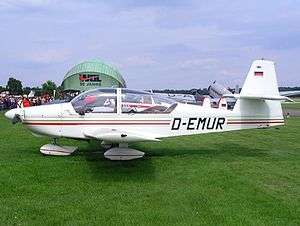Sportavia-Pützer RS 180 Sportsman
The Sportavia-Pützer RS-180 Sportsman is a four-seat sport aircraft that was produced in Germany in the late 1970s.[4]
| RS-180 Sportsman | |
|---|---|
 | |
| Role | Sport aircraft |
| National origin | Germany |
| Manufacturer | Sportavia-Pützer |
| Designer | René Fournier |
| First flight | 1978[1] |
| Number built | 18[2] |
| Unit cost |
DM 92,500 in 1978[3] |
| Developed from | Fournier RF-6 |
The aircraft is a conventional, low-wing cantilever monoplane with fixed tricycle undercarriage.[1] The pilot and passengers are seated in 2+2 configuration under a large bubble canopy.[5] The structure is of wood, covered in plywood and given an outer skin of fibreglass.[1]

Design and development
Rhein-Flugzeugbau (RFB) was founded in 1956. In 1976 it acquired the assets of Sportavia-Pützer, which had been formed in 1966 to take over from Alpavia SA the production of several light aircraft types designed by René Fournier. Sportavia-Pützer produced Fournier aircraft beginning in 1966, and in 1970 Fournier initiated the design of a new four-seat cabin monoplane, the Sportsman. The first prototype Sportsman first flew on 1 March 1973, but the second prototype, which made its maiden flight on 28 April 1976, was a completely redesigned version which was created by Sportavia. This redesigned model was designated the RF-6C Sportsman when it entered production in late 1976, and was renamed RS-180 Sportsman when a new empennage design was added in early 1978, following the fatal crash of the prototype in May 1977.[3] The extensive redesign included reshaping the horizontal tail and relocating it part-way up the fin,[3] changing the wing profile,[3] and removing the turned-down wingtips of the RF-6C.[3] In this form, the RS-180 gained German type certification in 1978.[6]
Basic structure of the Sportsman is wood, with a low-wing cantilever monoplane configuration. The surface is covered with fibreglass. A fixed nosewheel undercarriage with wheel fairings is used. The cabin employs a large bubble canopy.
At the end of 1980, Sportavia-Pützer was integrated into the RFB organisation, the RS-180 being re-designated FRB RS-180 Sportsman. Production was halted in early 1981, after fewer than two dozen units had been completed.[2][7]
Specifications (RS 180)
Data from Wurster 2001, p. 89; Mondey, p. 218
General characteristics
- Crew: one pilot
- Capacity: three passengers
- Length: 7.15 m (23 ft 5½ in)
- Wingspan: 10.5 m (34 ft 5½ in)
- Height: 2.56 m (8 ft 5 in)
- Wing area: 14.5 m2 (156.08 ft2)
- Aspect ratio: 7.60
- Empty weight: 640 kg (1,411 lb)
- Gross weight: 1,100 kg (2,425 lb)
- Powerplant: 1 × Lycoming O-360-A3A, 134 kW (180 hp)
Performance
- Maximum speed: 320 km/h (200 mph)
- Cruising speed: 225 km/h (140 mph)
- Range: 1,210 km (746 miles)
- Service ceiling: 5,400 m (17,715 ft)
Armament
Notes
- "Team Test 43: Sportavia RS 180", p. 88
- Simpson 1995, p. 378
- Barnett, Field, Hurst et al. 1978, p. 1438
- Taylor 1989, p.839
- "Team Test 43: Sportavia RS 180", p.89
- "Certification du RS 180 Sportsman", p. 42
- Mondey
References
- Barnett, Cliff; Hugh Field; Mike Hurst; Mark Lambert; Nigel Moll; Doug Richardson (13 May 1978). "Hanover Review". Flight International: 1436–48. Retrieved 13 March 2011.
- "Certification du RS 180 Sportsman". Aviation Magazine International: 42. 1978.
- Simpson, R.W. (1995). Airlife's General Aviation. Shrewsbury: Airlife.
- Mondey, David (1981). Encyclopedia of The World's Commercial and Private Aircraft. New York: Crescent Books. p. 218.
- Taylor, John W.R. (1977). Jane's All the World's Aircraft 1977–78. London: Jane's Yearbooks.
- Taylor, Michael J. H. (1989). Jane's Encyclopedia of Aviation. London: Studio Editions.
- "Team Test 43: Sportavia RS 180". Flight International: 88–95. 12 January 1980. Retrieved 13 March 2011.
- Wurster, Rolf (2001). 50 Jahre Deutsche Motorflugzeuge. Norderstedt: Books on Demand.